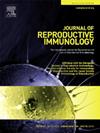Postpartum levels of circulating fetal microchimeric cells are lower after early-onset preeclampsia
IF 2.9
3区 医学
Q3 IMMUNOLOGY
引用次数: 0
Abstract
Fetal cells may persist in the mother following pregnancy, termed fetal microchimerism. These cells have been attributed positive and negative effects. The number of fetal cells transferred during pregnancy appears to be higher in preeclampsia. Here, we investigate whether fetal cell presence and quantity in the maternal circulation 1–8 years postpartum is influenced by a previous preeclamptic pregnancy. We also relate fetal cells detected postpartum to fetal cells detected during pregnancy, time since index pregnancy, parity, fetal sex and maternal characteristics. A cohort of 139 women was included in the present study: 21 with previous early-onset preeclampsia, 31 with previous late-onset preeclampsia and 87 with a clinically uncomplicated index pregnancy. Circulating fetal microchimerism was detected in maternal buffy coat using qPCR, targeting alleles unique to the fetus. Pregnancy buffy coat samples were available for 129 of the 139 included women. Early-onset, but not late-onset, preeclampsia was associated with reduced quantity of fetal microchimeric cells in maternal circulation postpartum. Fetal cells detected during pregnancy, time since index pregnancy, parity, fetal sex and maternal characteristics were not predictive of microchimerism postpartum in our cohort. Our findings suggest that early-onset, but not late-onset preeclampsia, affects circulating microchimerism postpartum. Our observation that fetal microchimerism postpartum did not correlate with number of fetal cells detected during pregnancy nor time since index pregnancy supports the notion that fetal microchimerism is a dynamic phenomenon, with fetal cells moving in and out of maternal circulation and surrounding tissues, possibly affected by the current physiologic state of the mother.
早发性子痫前期产后循环胎儿嵌合细胞水平较低
胎儿细胞可能在怀孕后持续存在于母亲体内,称为胎儿微嵌合。这些细胞有积极和消极的作用。在怀孕期间转移的胎儿细胞数量在子痫前期似乎更高。在这里,我们调查胎儿细胞的存在和数量在产后1-8年母体循环是否受到先前的子痫前期妊娠的影响。我们还将产后检测到的胎儿细胞与妊娠期间检测到的胎儿细胞、自指数妊娠以来的时间、胎次、胎儿性别和母体特征联系起来。本研究纳入了139名妇女:21名既往早发型先兆子痫,31名既往晚发型先兆子痫,87名临床无并发症指数妊娠。利用qPCR技术检测母猫黄毛中循环胎儿微嵌合现象,定位胎儿特有的等位基因。在139名女性中,有129名女性获得了怀孕时的灰褐色外套样本。早发性而非晚发性先兆子痫与产后母体循环中胎儿嵌合细胞数量减少有关。在我们的队列中,妊娠期间检测到的胎儿细胞、指数妊娠时间、胎次、胎儿性别和母亲特征不能预测产后微嵌合。我们的研究结果表明,早发性而非晚发性先兆子痫会影响产后循环微嵌合。我们观察到,产后胎儿微嵌合与妊娠期间检测到的胎儿细胞数量和时间无关,因为指数妊娠支持胎儿微嵌合是一种动态现象的观点,胎儿细胞在母体循环和周围组织中进出,可能受到母体当前生理状态的影响。
本文章由计算机程序翻译,如有差异,请以英文原文为准。
求助全文
约1分钟内获得全文
求助全文
来源期刊
CiteScore
6.30
自引率
5.90%
发文量
162
审稿时长
10.6 weeks
期刊介绍:
Affiliated with the European Society of Reproductive Immunology and with the International Society for Immunology of Reproduction
The aim of the Journal of Reproductive Immunology is to provide the critical forum for the dissemination of results from high quality research in all aspects of experimental, animal and clinical reproductive immunobiology.
This encompasses normal and pathological processes of:
* Male and Female Reproductive Tracts
* Gametogenesis and Embryogenesis
* Implantation and Placental Development
* Gestation and Parturition
* Mammary Gland and Lactation.

 求助内容:
求助内容: 应助结果提醒方式:
应助结果提醒方式:


